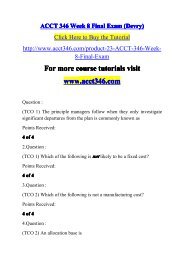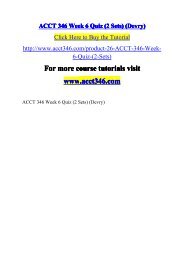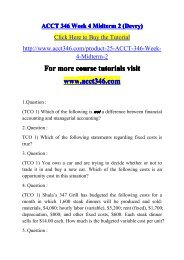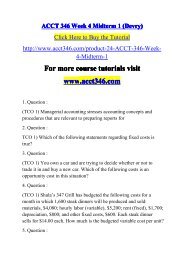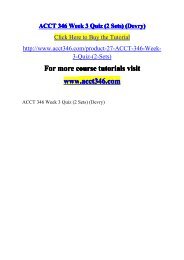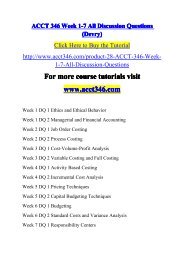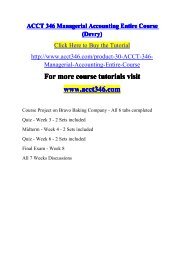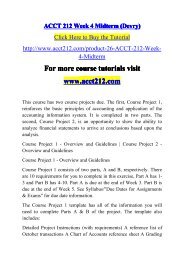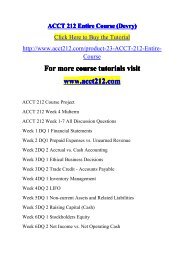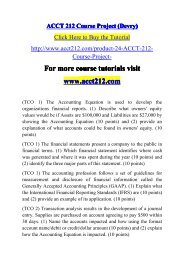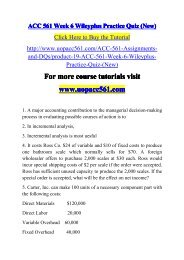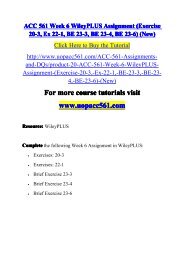ACCT 212 Final Exam (Devry) / acct212dotcom
For more course tutorials visit www.acct212.com At the end of the period it is necessary to close all temporary accounts. (1) Explain why this process is required (10 points) and (2) provide an example of the closing of an expense account, Supplies Expense in the form of a journal entry 2. (TCO 2) As required to complete Course Project 1, one must follow the cycle that includes 10 steps to complete the accounting cycle. (1) Explain how to construct an Unadjusted Trial Balance (10 points) and (2) provide an example of the application of the debit/credit rules in the development of the trial balance (TCO 5) Internal Control Procedures are required to safeguard company assets and to ensure ethical operation of the business. (1) Explain how limited access can satisfy the purpose of internal control (10 points) and (2) provide an example of how this control could be implemented 4. (TCO 4) Inventory valuation methods determine the cost of goods sold and the inventory balance. (1) Explain how the Last in First out (LIFO) method is applied (10 points) and (2) provide an example of the impact that this method of inventory valuation will have on Gross Profit 5. (TCO 1) To evaluate the financial operation and health of a business ratio analysis is used. (1) Provide the formula for the Acid-test (or Quick) Ratio and explain how it is computed (10 points) and (2) provide an example of how this ratio can be used in decision-making in business. 1. (TCO 6) BagODonuts Company bought a used delivery truck on January 1, 2010, for $19,200. The van was expected to remain in service 4 years (30,000 miles). BagODonuts’ accountant estimated that the truck’s residual value would be $2,400 at the end of its useful life. The truck traveled 8,000 miles the first year, 8,500 miles the second year, 5,500 miles the third year, and 8,000 miles in the fourth year TCO 7) ABC Inc. was incorporated on 1/15/12. Their corporate charter authorized the following capital stock: Preferred Stock: 7%, par value $100
For more course tutorials visit
www.acct212.com
At the end of the period it is necessary to close all temporary accounts. (1) Explain why this process is required (10 points) and (2) provide an example of the closing of an expense account, Supplies Expense in the form of a journal entry
2. (TCO 2) As required to complete Course Project 1, one must follow the cycle that includes 10 steps to complete the accounting cycle. (1) Explain how to construct an Unadjusted Trial Balance (10 points) and (2) provide an example of the application of the debit/credit rules in the development of the trial balance
(TCO 5) Internal Control Procedures are required to safeguard company assets and to ensure ethical operation of the business. (1) Explain how limited access can satisfy the purpose of internal control (10 points) and (2) provide an example of how this control could be implemented
4. (TCO 4) Inventory valuation methods determine the cost of goods sold and the inventory balance. (1) Explain how the Last in First out (LIFO) method is applied (10 points) and (2) provide an example of the impact that this method of inventory valuation will have on Gross Profit
5. (TCO 1) To evaluate the financial operation and health of a business ratio analysis is used. (1) Provide the formula for the Acid-test (or Quick) Ratio and explain how it is computed (10 points) and (2) provide an example of how this ratio can be used in decision-making in business.
1. (TCO 6) BagODonuts Company bought a used delivery truck on January 1, 2010, for $19,200. The van was expected to remain in service 4 years (30,000 miles). BagODonuts’ accountant estimated that the truck’s residual value would be $2,400 at the end of its useful life. The truck traveled 8,000 miles the first year, 8,500 miles the second year, 5,500 miles the third year, and 8,000 miles in the fourth year
TCO 7) ABC Inc. was incorporated on 1/15/12. Their corporate charter authorized the following capital stock:
Preferred Stock: 7%, par value $100
- No tags were found...
Create successful ePaper yourself
Turn your PDF publications into a flip-book with our unique Google optimized e-Paper software.
<strong>ACCT</strong> <strong>212</strong> <strong>Final</strong> <strong>Exam</strong> (<strong>Devry</strong>)Click Here to Buy the Tutorialhttp://www.acct<strong>212</strong>.com/product-27-<strong>ACCT</strong>-<strong>212</strong>-<strong>Final</strong>-<strong>Exam</strong>For more course tutorials visitwwwww.acct<strong>212</strong>..acct<strong>212</strong>.cocomAt the end of the period it is necessary to close all temporary accounts.(1) Explain why this process is required (10 points) and (2) provide anexample of the closing of an expense account, Supplies Expense inthe form of a journal entry2. (TCO 2) As required to complete Course Project 1, one mustfollow the cycle that includes 10 steps to complete the accountingcycle. (1) Explain how to construct an Unadjusted Trial Balance (10points) and (2) provide an example of the application of thedebit/credit rules in the development of the trial balance(TCO 5) Internal Control Procedures are required to safeguardcompany assets and to ensure ethical operation of the business. (1)Explain how limited access can satisfy the purpose of internal control(10 points) and (2) provide an example of how this control could beimplemented4. (TCO 4) Inventory valuation methods determine the cost of goodssold and the inventory balance. (1) Explain how the Last in First out(LIFO) method is applied (10 points) and (2) provide an example ofthe impact that this method of inventory valuation will have on GrossProfit
5. (TCO 1) To evaluate the financial operation and health of abusiness ratio analysis is used. (1) Provide the formula for the Acidtest(or Quick) Ratio and explain how it is computed (10 points) and(2) provide an example of how this ratio can be used in decisionmakingin business.1. (TCO 6) BagODonuts Company bought a used delivery truck onJanuary 1, 2010, for $19,200. The van was expected to remain inservice 4 years (30,000 miles). BagODonuts’ accountant estimatedthat the truck’s residual value would be $2,400 at the end of its usefullife. The truck traveled 8,000 miles the first year, 8,500 miles thesecond year, 5,500 miles the third year, and 8,000 miles in the fourthyearTCO 7) ABC Inc. was incorporated on 1/15/12. Their corporatecharter authorized the following capital stock:Preferred Stock: 7%, par value $100 per share, 100,000 shares.Common Stock: $1 par value, 500,000 shares.Fraud is an intentional misrepresentation of facts, made for thepurpose of persuading another party to act in a way that causes injuryor damage to that party. In our readings and discussions we have seenseveral examples of fraud in business. Using that experience (1)provide an example of a common fraudulent practice in business withan explanation of how the practice works and (2) name and describeeach of the elements of the Fraud Triangle) Internal Control Procedures are in place to protect the assets ofevery business as mentioned in the textbook and our discussions. Ofthe seven internal control procedures, list five of these controls anddescribe how each procedure is implemented. (5 points each with 2points for listing and 3 points for a description)Below are the accounts of Super Pool Service, Inc. The accounts havenormal balances on June 30, 2012. The accounts are listed in noparticular order.
Account BalanceCommon stock $5,100Accounts payable $4,400Service revenue $17,100Land $28,800Note payable $9,500Cash $5,200Dividends $6,100Utilities expense $2,100Accounts receivable $10,600Delivery expense $700Retained earnings $25,600Salary expense $8,200Prepare the company’s trial balance as of June 30, 2012, listingaccounts in proper sequence, as illustrated in the chapter. For example,Accounts Receivable comes before Land. List the expense with thelargest balance first, the expense with the next largest balance second,and so on.Linda’s Lampshades started business on Jan. 1, 2001. They had thefollowing inventory transactions:



